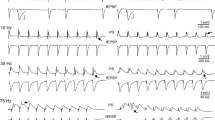Summary
-
1.
The spatial organization of the efferent projections of CA1 and CA3 hippocampal pyramids has been studied using recordings of fibre volleys, orthodromic and antidromic population spikes and synaptic field potentials, following microelectrode stimulation of the fimbria, CA1 alveus, or subiculum.
-
2.
Only CA3 pyramidal cells were found to send their axons into the fimbria. In the septal two thirds of the hippocampus the CA1 pyramidal cells project in a caudal direction to the pyramidal part of the subiculum. The temporal third was not explored for technical reasons.
-
3.
Fimbrial fibres are arranged in a strictly parallel fashion, the rostro-medial CA3 cells distributing their axons near to the hippocampus, while those located at the temporal extreme distribute their axons to the outer edge of the fimbria. The organization of the Schaffer collaterals and the projections of the CA1 cells consisted of parallel lamellae, oriented nearly transversely to the longitudinal axis of the hippocampus in rabbits (more obliquely in cats). The findings indicate that CA3 cell discharge via the Schaffer collaterals represents a major input driving the CA1 cells.
-
4.
The dichotomy with regard to hippocampal output suggests that the CA3 and CA1 regions of the hippocampus may subserve different functions, thus probably participating differentially in various behavioural situations.
-
5.
This organization makes it possible to study the behaviour of animals with selective and regional de-efferentation of the CA3 or of the CA1 regions by making discrete lesions in the fimbria and alveus, respectively. Alternatively, recording the fibre volley from the fimbria may provide a useful monitor of the output of the CA3 region during different behaviours.
Similar content being viewed by others
References
Adey, W.R.: Hippocampal states and functional relations with corticosubcortical systems in attention and learning, pp. 228–245. In: W.R. Adey and T. Tokizane (eds.): Progress in brain research. 27. Structure and function of the limbic system. Amsterdam: Elsevier 1967.
Andersen, P.: Interhippocampal impulses. II. Apical dendritic activation of CA1 neurones. Acta physiol. scand. 48, 178–208 (1960).
— Bliss, T.V.P., Skrede, K.K.: Unit analysis of hippocampal population spikes. Exp. Brain Res. 13, 208–221 (1971a).
—: Lamellar organization of hippocampal excitatory pathways. Exp. Brain Res. 13, 222–238 (1971b).
— Holmqvist, B., Voorhoeve, P.E.: Excitatory synapses on hippocampal apical dendrites activated by entorhinal stimulation. Acta physiol. scand. 66, 461–472 (1966).
— Jansen, J., jr.: The local cortical response in the hippocampus of rabbit. Arch. ital. Biol. 99, 349–368 (1961).
— Lømo, T.: Mode of activation of hippocampal pyramidal cells by excitatory synapses on dendrites. Exp. Brain Res. 2, 247–260 (1966).
Dalton, A., Black, A.H.: Hippocampal electrical activity during the operant conditioning of movement and refraining from movement. Comm. behav. Biol. A2, 267–273 (1968).
Elazar, Z., Adey, W.R.: Spectral analysis of low frequency components in the electrical activity of the hippocampus during learning. Electroenceph. clin. Neurophysiol. 23, 225–240 (1967a).
— Electroencephalographic correlates of learning in subcortical and cortical structures. Electroenceph. clin. Neurophysiol. 23, 306–319 (1967b).
Euler, C. Von, Green, J.D., Ricci, G.: The role of hippocampal dendrites in evoked responses and after-discharges. Acta physiol. scand. 42, 87–111 (1960).
Gloor, P., Vera, C.L., Sperti, L.: Electrophysiological studies of hippocampal neurons. I. Configuration and laminar analysis of the ‘resting’ potential gradient, of the main transient response to perforant path, fimbrial and mossy fibre volleys and of ‘spontaneous’ activity. Electroenceph. clin. Neurophysiol. 15, 353–378 (1963).
Grastyán, E., Karmos, G., Vereczkey, L., Kellényi, L.: The hippocampal electrical correlates of the homeostatic regulation of motivation. Electroenceph. clin. Neurophysiol. 21, 34–53 (1966).
— Lissák, K., Madarász, F., Donhoffer, H.: Hippocampal electrical activity during the development of conditioned reflexes. Electroenceph. clin. Neurophysiol. 11, 409–430 (1959).
Hern, J.E.C., Landgren, S., Phillips, C.G., Porter, R.: Selective excitation of corticofugal neurones by surface-anodal stimulation of the baboon's motor cortex. J. Physiol. (Lond.) 161, 73–90 (1962).
Hjorth-Simonsen, A.: Some intrinsic connections of the hippocampus in the rat: an experimental analysis. J. comp. Neurol. 147, 145–161 (1973).
Hubel, D.H.: Tungsten microelectrode for recording from single units. Science 125, 549–550 (1959).
Lorente de Nó, R.: Studies on the structure of the cerebral cortex. II. Continuation of the study of the Ammonic system. J. Psychol. Neurol. (Lpz.) 46, 113–177 (1934).
Nauta, W.J.H.: An experimental study of the fornix in the rat. J. comp. Neurol. 104, 247–270 (1956).
Patton, H.D., Ammassian, V.E.: Single- and multiple-unit analysis of cortical stage of pyramidal tract activation. J. Neurophysiol. 17, 345–363 (1954).
Raisman, G.: The connexions of the septum. Brain 89, 317–348 (1966).
— Cowan, W.M., Powell, T.P.S.: An experimental analysis of the efferent projection of the hippocampus. Brain 89, 83–108 (1966).
Ramón y Cajal, S.: Histologie du système nerveux de l'Homme et des Vertébrés. Paris: A. Maloine 2, 993 (1911).
Siegel, A., Tassoni, S.P.: Differential efferent projections from the ventral and dorsal hippocampus of the cat. Brain Behav. Evol. 4, 185–200 (1971).
Vanderwolf, C.H.: Hippocampal electrical activity and voluntary movement in the rat. Electroenceph. clin. Neurophysiol. 26, 407–418 (1969).
Votaw, C.L.: Certain functional and anatomical relations of the cornu ammonis of the macaque monkey. I. Functional relations. J. comp. Neurol. 112, 353–382 (1959).
— Certain functional and anatomical relations of the cornu ammonis of the macaque monkey. II. Anatomical relations. J. comp. Neurol. 114, 283–293 (1960).
Whishaw, I.Q., Bland, B.H., Vanderwolf, C.H.: Hippocampal activity, behaviour, self-stimulation, and heart rate during electrical stimulation of the lateral hypothalamus. J. comp. physiol. Psychol. 79, 115–127 (1972).
Author information
Authors and Affiliations
Additional information
NATO Post-Doctoral Fellow.
On leave of absence from the Department of Physiology and Biophysics, Dalhousie University, Halifax, Nova Scotia, Canada.
Rights and permissions
About this article
Cite this article
Andersen, P., Bland, B.H. & Dudar, J.D. Organization of the hippocampal output. Exp Brain Res 17, 152–168 (1973). https://doi.org/10.1007/BF00235025
Received:
Issue Date:
DOI: https://doi.org/10.1007/BF00235025




